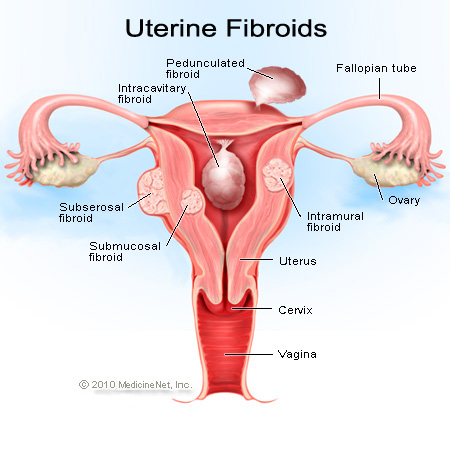Fibroids

What is Fibroids?
Fibroids are non-cancerous (benign) tumors that grow from the muscle layers of the uterus (womb). They are also known as uterine fibroids, myomas, or fibromyomas. The singular of uterine fibroids is Uterine Fibroma. Fibroids are growths of smooth muscle and fibrous tissue. Fibroids can vary in size, from that of a bean to as large as a melon.
Fibroids affect at least 20% of all women at sometime during their life. Women aged between 30 and 50 are the most likely to develop fibroids. Overweight and obese women are at significantly higher risk of developing fibroids, compared to women of normal weight.
Malignant (cancerous) growths on the smooth muscles inside the womb can develop, called leiomyosarcoma of the womb. However, this is extremely rare.
FOUR TYPES OF FIBROIDS-
There are four types of fibroids and these are:
1. Intramural These are located in the wall of the uterus. These are the most common types of fibroids.
2. Subserosal fibroids These are located outside the wall of the uterus. They can develop into pedunculated fibroids (stalks). Subserosal fibroids can become quite large.
3. Submucosal fibroids These are located in the muscle beneath the lining of the uterus wall.
4. Cervical fibroids These are located in the neck of the womb (the cervix)
CAUSES OF FIBROIDS-
Experts cannot come to a common consensus about why fibroids occur.
During a woman's reproductive years her estrogen and progesterone levels are high. When estrogen levels are high, especially during pregnancy, fibroids tend to swell. When estrogen levels are low fibroids may shrink, e.g. during a woman's menopause.
Heredity may also be a factor. Women whose mothers and/or sisters have/had fibroids have a higher risk of developing them too.
SYMPTOMS OF UTERINE FIBROIDS:
WMost women have no symptoms. That is why most patients with fibroids do not know they have them. When symptoms do develop, they may include:
Anemia (as a result of heavy periods)
Backache
Constipation
Discomfort in the lower abdomen (especially if fibroids are large)
Frequent urination
Heavy painful periods
Pain in the legs
Painful sex
Swelling in the lower abdomen (especially if fibroids are large)
DIAGNOSIS OF FIBROIDS
In most cases, the symptoms of fibroids are rarely felt and the patient does not know she has them. They are usually discovered during a vaginal examination.
UltrasoundIf the doctor thinks fibroids may be present he/she may use an ultrasound scan to find out. Ultrasound can also eliminate other possible conditions which may have similar symptoms. Ultrasound scans are often used when the patient has heavy periods and blood tests have revealed nothing conclusive.
Trans-vaginal scanA small scanner is inserted into the patient's vagina so that the uterus can be viewed close up.
HysteroscopyThis is a small telescope that examines the inside of the uterus. During this procedure, if necessary, a biopsy can be taken of the lining of the uterus (womb).
LaparoscopyA laparoscope is a small device that looks at the outside of the uterus - where the doctor examines its size and shape. A laparoscope is a small flexible tube.
BiopsyA small sample of the lining of the uterus is taken and then examined under a microscope.